


General Simulation Description
Follow the path of acetyl-CoA through the Krebs cycle — release carbon dioxide, generate NADH and FADH₂, and see how cells harvest energy one step at a time.
About
Dive deeper into aerobic respiration with an immersive exploration of the Krebs cycle. In this interactive simulation, students work with acetyl-CoA to observe how carbon dioxide is released, energy carriers NADH and FADH₂ are formed, and ATP is produced — demonstrating how cells extract energy-rich molecules during this phase of cellular respiration. They follow instructions and add reactants to drive the process forward.
Choose your curriculum
Our catalog